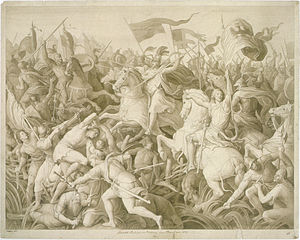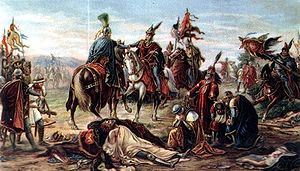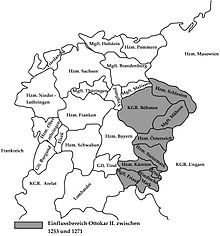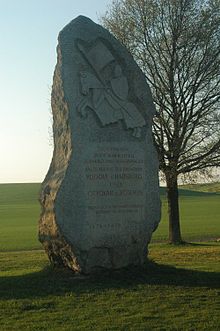- Battle on the Marchfeld
-
Battle on the Marchfeld Part of the Rudolph's effort to recognising his rule over the Holy Roman Empire 
Battle of Rudolph of Habsburg against Ottokar of Bohemia. A drawing by Julius Schnorr von Carolsfeld, 1835Date August 26, 1278 Location between Dürnkrut and Jedenspeigen in the present-day Austrian state of Lower Austria Result Habsburg-Hungarian victory Belligerents  Holy Roman Empire
Holy Roman Empire
 Austrian lands
Austrian lands
 Kingdom of Hungary (including Cumans and Szeklers)
Kingdom of Hungary (including Cumans and Szeklers)
& mercenaries: Swabians, Styrians, Bavarians etc. Kingdom of Bohemia
Kingdom of Bohemia
& mercenaries: Brandenburgians, Meissens, Silesians, Poles etc.Commanders and leaders  Rudolf von Habsburg
Rudolf von Habsburg
 King Ladislaus IV His Commanders: Stephen Gutkeled and Matthew Csák
King Ladislaus IV His Commanders: Stephen Gutkeled and Matthew Csák Přemysl II. Otakar †
Přemysl II. Otakar †Strength ~30,000[1]
~21,000 (out of it 2–3,000 Rudolf's & 18,000 László's combatants)[2]~25–30,000[1] Casualties and losses Unknown ~12,000 The Battle on the Marchfeld (i.e. Morava Field; Czech: Bitva na Moravském poli) at Dürnkrut and Jedenspeigen took place on August 26, 1278 and was a decisive event for the history of Central Europe for the following centuries. The opponents were the Bohemian (Czech) army led by king Ottokar II of Bohemia and the Imperial army led by Rudolph I of Habsburg in alliance with King Ladislaus IV of Hungary. The Hungarian army included heavy cavalry as well as Cuman horse archers.
Contents
Background
The deposition of emperor Frederick II of Hohenstaufen by Pope Innocent IV in 1245 created a grave crisis for the Holy Roman Empire, as in the following decades several nobles were elected as Rex Romanorum and Emperor-to-be, none of whom were able to gain actual governing power upon the Emperor's death in 1250. That same year, Ottokar II, son of king Wenceslaus I of Bohemia, moved into the princeless Duchies of Austria and Styria, where he was proclaimed Duke by the estates one year later.
In 1253 Ottokar II became Bohemian king after the death of his father; his gain in power was viewed with suspicion by King Béla IV of Hungary, who campaigned in Styria and Austria but was finally defeated at the 1260 Battle of Kressenbrunn. In 1268 Ottokar signed a contract of inheritance with the last Carinthian duke of the House of Sponheim, Ulric III, and acquired Carinthia including the March of Carniola and the Windic March one year later. At the height of his power he aimed at the Imperial crown, but the Princes, distrustful of his steep rise, elected the "little count" Rudolph of Habsburg Rex Romanorum on September 29, 1273.
Preparations
As the election had taken place in his absence, Ottokar did not acknowledge Rudolph as King. Rudolph himself had promised to regain the "alienated" territories which had to be conferred by the Imperial power with consent of the Prince-electors. He claimed the Austrian and Carinthian territories for the Empire and summoned Ottokar to the 1275 Reichstag at Würzburg. By not appearing before the Diet, Ottokar set the events of his demise in motion. He was placed under the imperial ban and had all his territorial rights revoked, including even his Bohemian inheritance.
Meanwhile, Rudolph was gathering allies and preparing for battle. He achieved two of these alliances through the classic Habsburg style – marriage. First, he married his son Albert to Elisabeth of Gorizia-Tyrol. In return, her father Count Meinhard II of Gorizia-Tyrol received the Duchy of Carinthia as a fief. Second, he established an - unstable - alliance with Duke Henry I of Lower Bavaria by offering him his daughter Katharina as wife for his son Otto in addition to the region of present-day Upper Austria as a pledge for her dowry. He also concluded an alliance with King Ladislaus IV of Hungary, who intended to settle old scores with Ottokar.
Rudolph, so strengthened, besieged Ottokar at Vienna in 1276. Ottokar was forced to renounce all of his acquisitions and received Bohemia and Moravia only as a fief by King Rudolph. So heavily deprived, he attempted to regain his territories, contracted an alliance with the Margraves of Brandenburg and in 1278 campaigned in Austria. Ottokar first laid siege to the towns of Drosendorf and Laa an der Thaya, while Rudolph left Vienna to face him in an open pitched battle where the Cuman cavalry of King Ladislaus could easily join his forces.
The battle
 Kings Ladislaus and Rudolph of Habsburg meet over the dead body of King Ottokar. A romantic painting by Mór Than, 1872. Such patriotic-tinged works were common in the Czech, German and Hungarian milieux during the 19th century
Kings Ladislaus and Rudolph of Habsburg meet over the dead body of King Ottokar. A romantic painting by Mór Than, 1872. Such patriotic-tinged works were common in the Czech, German and Hungarian milieux during the 19th century
Ottokar abandoned the siege and on August 26 Ottokar met the troops of Rudolph and Ladislaus near Dürnkrut. When he arrived his enemies had already taken the opportunity to explore the topography of the future battleground. The Bohemian troops were embroiled in heavy attacks by the Cuman forces in the morning. As the battle wore on, Ottokar's cavalry seemed to gain the upper hand, when even Rudolph's horse was killed under him and the 60-year-old narrowly escaped with his life.
After three hours of continued fighting Ottokar's knights in their heavy armour were exhausted. At noon Rudolph ordered a fresh Austrian and Hungarian heavy cavalry regiment he had concealed behind nearby hills and woods to attack the flank of Ottokar's troops. Though such ambushes were commonly regarded as dishonourable in warfare, the attack from the rear prevailed in stampeding the Bohemian troops, resulting in a decisive victory of Rudolph and his allies. Ottokar's camp was plundered, and he himself was found slain on the battlefield.
Aftermath
Rudolph assured his possession of the Duchies of Austria and Styria, the heartland and foundation of the rise of the House of Habsburg. In 1282 he installed his sons Albert and Rudolf II as Austrian dukes. However in Bohemia Rudolph acted cautiously and reached an agreement with the nobility and Ottokar's widow Kunigunda of Slavonia on the succession of her son Wenceslaus II to the throne. On the same occasion he reconciled with the Brandenburg margraves, ceding them the guardianship over the minor heir apparent. King Ladislaus IV exerted himself in the christianization of the Cuman warriors, before he was assassinated in 1290.
Battle on the Marchfeld in art and popular culture
The battle was depicted in art especially during the 19. century, when it was viewed as the example of tradional cooperation between Habsburg dynasty (Austria) and Kingdom of Hungary from one side and the tradional tension between Habsburg dynasty and Bohemia from the Czech side.
The tragedy König Ottokars Glück und Ende written by Franz Grillparzer in 1823 is based on the rise and fall of king Ottokar II. This drama was originally inspired by the life of Napoleon, though Grillparzer, fearing Metternich's censorship, chose to write the play about Ottokar, in whose story he found many parallels. It nevertheless was immediately forbidden and could not be performed until 1825.
The opera The Brandenburgers in Bohemia composed by Czech composer Bedřich Smetana in 1863 was inspired by this battle and following events as well.
See also
- Battle of Kressenbrunn
- List of battles 601-1400
Notes
- ^ a b See books in References
- ^ According to: Small lexicon of the Battles ISBN 963-645-080-3, by: Attila and Balázs Weiszhár; Military history of Hungary ISBN 963-32-6337-9, by: Ervin Liptai; Kurt Peball: Die Schlacht bei Dürnkrut am 26. August 1278. Österreichischer Bundesverl. f. Unterricht, Wissenschaft u. Kunst, Wien 1968.
References
- Schmitt, Richard; Strasser Peter (2004) (in German). Rot-weiß-rote Schicksalstage: Entscheidungsschlachten um Österreich (Red-White-Red Fatal Days: The Decisive Battles in Austria). St. Pölten: NP Buchverlag. ISBN 3-85326-354-2.
- Andreas Kusternig: 700 Jahre Schlacht bei Duernkrut und Jedenspeigen. Wien 1978.
- Kofránková, Václava (2006) (in Czech). 26. 8. 1278 – Moravské pole: poslední boj Zlatého krále (Marchfeld: The Last Fight of Golden King). Praha: Havran. ISBN 80-86515-71-0.
- Žemlička, Josef (1998) (in Czech). Století posledních Přemyslovců (The Century of the Last Přemyslids). Praha: Melantrich. ISBN 80-7023-281-1.
- Mika, Norbert (2008) (in Polish). Walka o spadek po Babenbergach 1246–1278 (War of the Babenbergian Succession). Racibórz: WAW Grzegorz Wawoczny. ISBN 978-83-919765-4-8.
Coordinates: 48°28′53.45″N 16°52′38.34″E / 48.4815139°N 16.8773167°ECategories:- 1278 in Europe
- History of Austria
- Czech history
- History of Hungary
- Battles involving Bohemia
- Battles involving Hungary
- Battles of the Middle Ages
- Conflicts in 1278
Wikimedia Foundation. 2010.


